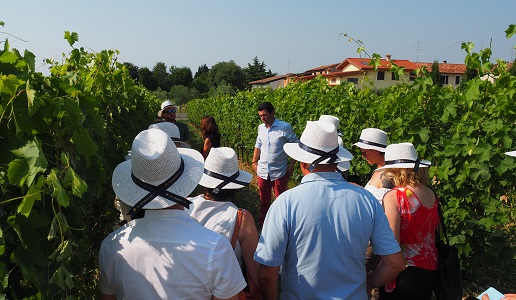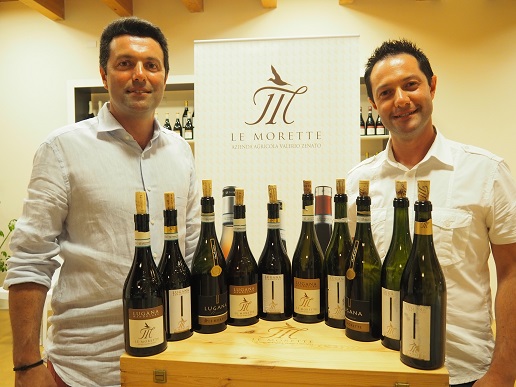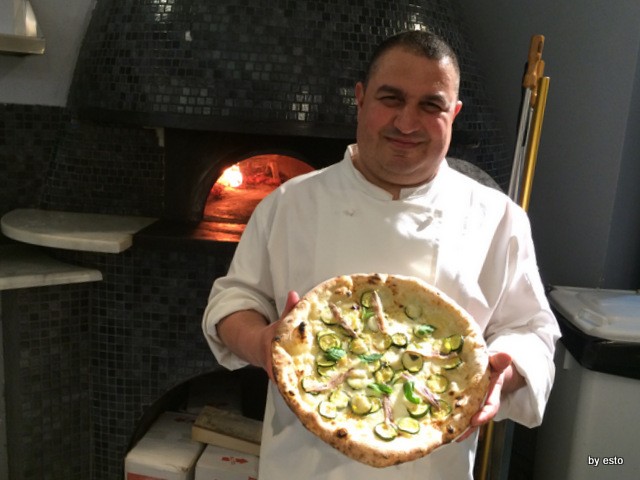Lugana: the climate factor

Marco Tonni from the Consorzio di Tutela producers’ association has made an interesting study of climate conditions in the Lugana appellation over the past ten years.
I was able to significantly enhance my knowledge of the Lugana appellation thanks to an interesting study by agronomist Marco Tonni that was presented at the La Moretta estate in Peschiera del Garda, an established, family-run estate today in the hands of brothers Fabio and Paolo Zenato, the third generation of winemakers and nursery operators.
In the study, Ten Years of Climate in Lugana, Marco Tonni, a member of the SATA agronomist studio and an executive at the Consorzio di Tutela producers’ association, underscored how important it was to have a clear understanding of the Lugana terroir and how this constituted a way for producers to properly interpret the land and the Turbiana varietal year after year.
The report focused on different elements that all interacted between them and I will try to sum them up here:
 Terroir Lugana
Terroir Lugana
Soils: these are sedimentary of glacial origin, for the most part clay, up to 70%; limy up to 40%; chalky up to 40%; and for a good part free of gravel. Thus the soils are heavy and compact with little organic substances and thus have difficulty breathing. With these characteristics, the method of working the soil is of fundamental and determining importance for the health and productivity of the plant.
Climate: in Lugana, there are vines that “look out” over Lake Garda (very picturesque but difficult to farm) as well as in hilly areas. The appellation is to the south of the glacial lake where the winds, frequent rainfall and changes in temperature play a major role. This beginning from when the vines begin to bud.
Vineyards: Turbiana is a generous varietal but not easy to find given its low fertility. Thus it needs particular attention in the vineyards, be it for managing the shading leaves in the summer (when temperatures can hit 50°C) be it during pruning and tying the vines. The vines are trained for the most part using the arch and Guyot methods.
Man: then there is man’s intervention. In Lugana, the vineyards are situated between numerous and populated towns and villages and the machinery used in the vineyards tend to compact the soil even further year after year. History and tradition are other elements to keep in consideration.
 Characteristics of the years
Characteristics of the years
With the information available it is possible to sum up in a simple way the years from 2008 to 2016:
* 2008: wet spring
* 2009: hot
* 2010: cool
* 2011: hot but interesting for white wines
* 2012: dry in September
* 2013: balanced
* 2014: cool
* 2015 hot and dry
* 2016: balanced
Following the presentation, we reinforced our newly acquired knowledge thanks to the Lugana wines from Le Morette in a blind tasting that was in its own way unique. It was the brainchild of the Zenato brothers and Nicola Frasson, a contributor and taster for Gambero Rosso, and involved ten wines, a range of ten vintages, and focused on three types of wine: Lugana Mandolara, Lugana Benedictus and Lugana Riserva.
It was an interesting experience to say the least that was both fun and informative. Guessing the vintage of the wines was made easier by the hints given by the agronomist. In order to guess the type of wine, however, we needed help from producers who identified Mandolara as the Lugana to first reach the market and that was accessible and fermented and matured in stainless steel. Benedictus, on the other hand, was decidedly a “special recipe” from Fabio Zenato, in part fermented in barriques where the wine later matured. The Riserva employed the use of “natural” yeasts and matured longer in wood. All the wines were well-made and had great personality, while remaining connected with the terroir.
The following is the wine that impressed me the most:
.jpg) Lugana Riserva 2016 Le Morette
Lugana Riserva 2016 Le Morette
93/100 - € 17,00
Made from Turbiana (Trebbiano di Lugana) grapes with brief, cold maceration before fermentation. Part of the wine ages in small oak casks and matures for 12 months sur lie (on the lees).
It has a golden, straw-yellow color. The bouquet is creamy and floral with notes of chamomile followed by sensations that are more taut and vertical. Acidity and sapidity dominate the mouthfeel where there is a thread of freshness despite the enormous complexity of this wine. The flavor is rich and the persistence is already excellent even though the wine is only at the beginning of its career.
The 2019 harvest
In conclusion, we add a few considerations made with Fabio Zenato on the recently concluded harvest. The 2019 harvest, which benefitted from favorable weather as the grapes achieved maturity, began in mid-September. This year was a more typical one for Turbiana, which in the previous few years had to be picked 10-15 days ahead of time. The cool temperatures and the rain in May were followed by more normal weather. The harvest was slightly lower below normal in regard to quantity and this improved the overall quality. Frequent summer rain avoided any risk of drought, also thanks to the capacity of clay to retain water. The weather in September and early October saw warm days and cool nights right through harvest and provided the grapes with excellent aromas and a nice acidity, setting the stage for a nice complexity.
Related Products
| Product | Producer | Date of publication | Author | Read | |
|---|---|---|---|---|---|

|
Lugana Riserva 2016
Lugana |
Le Morette | 11/20/19 | Sissi Baratella |
Made from Turbiana grapes with brief, cold maceration before fermentation and in part matured in small oak casks. The wine matures for 12 months sur lie and has a Golden, straw-yellow color. The... Leggi tutto |

|
Le Morette
|
11/20/19 | Redazione |
A lovely and very valid estate, one of the best in the Lugana area. Its 32 hectares of vineyards are divided into three bodies, two in San Benedetto di Lugana and one closer to Lake Garda in... Leggi tutto |

 Italiano
Italiano








